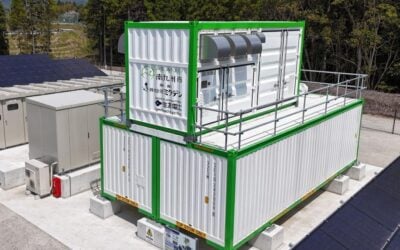UK-based residential storage maker Moixa, which is currently trialling a pilot deployment of 250 connected systems, is one of the key players indentified by the Navigant report. Image: Moixa.
The importance of technologies and services that enable effective energy storage including software and systems integration, is set to grow more than 30 times over in the next nine years, a new report claims.
Colorado-headquartered Navigant Research has issued “Energy Storage Enabling Technologies” (“ESET”), an analysis of the global market. The firm says that from expected annual revenues of around US$605 million this year, the market for ESET could be worth US$21 billion by 2024.
Enjoy 12 months of exclusive analysis
- Regular insight and analysis of the industry’s biggest developments
- In-depth interviews with the industry’s leading figures
- Annual digital subscription to the PV Tech Power journal
- Discounts on Solar Media’s portfolio of events, in-person and virtual
Taking the market and splitting it into four segments, utility-scale, commercial, residential and community, Navigant calls ESETs “a critical component of the energy storage value chain”. The sectors are all examined from the global scene, with the exception of utility-scale storage, which is looked at as four distinct markets – North America, Europe, Asia Pacific and a separate section looking at islands.
The report’s authors say power conversion hardware – primarily including but not limited to – inverters, software and controls at system level, and services and technologies built around systems integration are starting to face greater scrutiny than before, with vendors now “under pressure to deliver more consistent pricing”.
According to principal research analyst Anissa Dehamna, providers of non-battery components of storage systems are seeking to follow the general trend for cost reduction seen in batteries.
“Now that battery prices have responded to cost pressures, the associated technologies—i.e., the ESET portion of system cost—are starting to follow suit,” Dehamna said.
Britain’s 6MWh ‘Big Battery’ trial, which was worked on by companies including Younicos and S&C Electric. Image: S&C Electric.
IHS research manager Sam Wilkinson, who specialises in solar energy technologies, recently said that software choices in particular are beginning to not only define storage systems but also from a critical part of the design process and financial decision making.
“Ultimately, in almost every case, the business model for storage relies on the technology being extremely accurate, intelligent and responsive. The software is also the owner or operator’s window into the system and could be a major factor in his decision of whether to buy storage, and which system to use,” Wilkinson said.
Of the three areas highlighted by the report, system integrators are likely to take the lion’s share of the market, Navigant believes. Meanwhile power conversion technologies, consisting primarily of hardware components, are likely to see significant reductions in cost as the market takes off and manufacturers begin to achieve scale, in a similar way to the system cost reductions seen in the lithium-ion space in recent times.
The report also identifies a number of key industry players. These include US companies Ideal Power, Green Charge Networks, Greensmith and CODA Energy, systems integrators S&C Electric and NEC Energy Solutions, battery management start-up Younicos and big players from a number of other areas that also have an interest in storage such as Sharp and ABB. SAFT, which makes batteries as well as deploying them, was also picked out for focus.
In an interview with PV Tech Storage last week, Greensmith CEO John Jung said that during the early days of his company the energy storage industry was keen to focus on finding the right battery to solve many of the questions of grid congestion and other problems storage could be used to combat. However, Jung said, Greensmith went for a “battery agnostic” approach, hypothesising instead that different batteries would be used for different applications and that there was not one single answer.
“When we started out in 2008 there were a lot of industry claims that whoever came up with the better or best batteries would solve all the issues associated with energy storage,” Jung said.
“Our view has always been that it’s a system-type problem and an opportunity, and while batteries are important, that’s just simply a ticket to the ball game. It’s really about understanding the nature of the grid congestion problems that you want to solve and devising a complete system inclusive of bleeding edge software that allows you to do that meaningfully.
“We also thought that it was horses for courses of how you utilise battery technology. In that there is no single battery that’s going to be appropriate for all different applications.”






